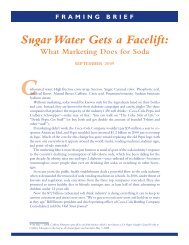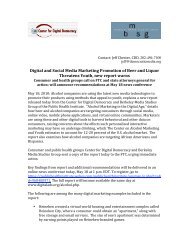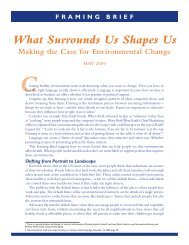"Interactive Food & Beverage Marketing" (PDF)
"Interactive Food & Beverage Marketing" (PDF)
"Interactive Food & Beverage Marketing" (PDF)
You also want an ePaper? Increase the reach of your titles
YUMPU automatically turns print PDFs into web optimized ePapers that Google loves.
<strong>Interactive</strong> <strong>Food</strong> & <strong>Beverage</strong> Marketing | Citations 278 ‒ 296<br />
http://investors.interpublic.com/phoenix.zhtml?c=87867&p=irolnewsArticle&ID=877174&highlight=.<br />
Microsoft has established a global interactive<br />
advertising facility, adLab, based in Beijing, whose mission is to “research and<br />
incubate advanced technologies” and “provide advertisers with rich targeting<br />
capabilities based on audience intelligence information....” Roger Park, “Microsoft<br />
adLab and TV Ad Tech,” iMedia Connection, 17 Jan. 2006, http://www.imediacon<br />
nection.com/news/7835.asp. Among the projects Microsoft is working on are<br />
“video hyperlink ads, which can detect product items displayed on a television<br />
screen during a show or commercial.” Microsoft’s TV ad technology allows consumers<br />
to zoom into products featured on the television screen and click through<br />
to detailed product descriptions and information on where the products can be<br />
bought. “‘The Microsoft team of top researchers in this field is unsurpassed and<br />
certain to produce compelling advances that will impact and ultimately change<br />
the game in online advertising. With this long-term applied research, we will continue<br />
to help improve advertisers’ return on investment by delivering rich audience<br />
intelligence information and enabling simple and complete control over all<br />
aspects of the advertising campaigns,’ says Tarek Najm, general manager of<br />
adCenter at Microsoft.” “Microsoft adCenter Incubation Lab Unveils Global<br />
Technology for Digital Advertising Industry,” press release, 12 Jan. 2006,<br />
http://www.microsoft.com/presspass/press/2006/jan06/01-<br />
12adCenterLabPR.mspx (all viewed 1 Apr. 2007).<br />
278 “Piper Jaffray Predicts Global Online Advertising Revenue to Reach $81.1<br />
Billion by 2011 in New Report: ‘The User Revolution,’“ press release, 23 Feb.<br />
2007, http://www.piperjaffray.com/1col.aspx?id=287&releaseid=966627 (viewed<br />
1 Apr. 2007).<br />
279 Rebecca Lieb, “2020 Vision: The Future of Advertising,” ClickZ Network, 26<br />
Jan. 2007, http://www.clickz.com/showPage.html?page=3624716 (viewed 1 Apr.<br />
2007).<br />
280 P. K. Newby, “Introduction: Moving Forward the Discussion on Childhood<br />
Obesity,” Journal of Law, Medicine & Ethics, vol. 35, no. 1 (Spring 2007). Marlene<br />
B. Schwartz and Kelly D. Brownell, “Actions Necessary to Prevent Childhood<br />
Obesity: Creating a Climate for Change,” Journal of Law, Medicine & Ethics, vol.<br />
35, no. 1 (Spring 2007). For a good discussion of the need to promote public policies<br />
that will improve the environment rather than focusing on individual behaviors,<br />
see Lori Dorfman and Lawrence Wallack, “Moving Nutrition Upstream: The<br />
Case for Reframing Obesity,” Journal of Nutrition Education and Behavior, vol. 39,<br />
no. 2S (Mar./Apr. 2007), S45-S50.<br />
281 See Schor and Ford, “From Tastes Great to Cool.”<br />
282 Kaiser Family Foundation, “New Study Finds That <strong>Food</strong> is the Top Product<br />
Seen Advertised by Children—Among All Children, Tweens See the Most <strong>Food</strong> Ads<br />
at More than 20 a Day,” press release, 28 Mar. 20007, http://www.kff.org/<br />
entmedia/entmedia032807nr.cfm (viewed 1 Apr. 2007).<br />
283 “Marketing, Self-Regulation, and Childhood Obesity: A Joint Workshop of the<br />
Federal Trade Commission and the Department of Health and Human Services,”<br />
FTC, 14-15 July 2005, http://www.ftc.gov/bcp/workshops/foodmarketingtokids/<br />
(viewed 1 Apr. 2007).<br />
284 “FTC, HHS Release Report on <strong>Food</strong> Marketing and Childhood Obesity:<br />
Recommends Actions by <strong>Food</strong> Companies and the Media,” press release, 2 May<br />
2006, http://www.ftc.gov/opa/2006/05/childhoodobesity.htm. According to an<br />
announcement published in the Federal Register, the FTC “will seek data regarding,<br />
among other things: (1) the types of foods marketed to children and adolescents;<br />
(2) the types of measured and unmeasured media techniques used to market<br />
products to children and adolescents; (3) the amount spent to communicate<br />
marketing messages in measured and unmeasured media to children and adolescents;<br />
and (4) the amount of commercial advertising time in measured media<br />
directed to children and adolescents that results from this spending.” FTC,<br />
“Commission Seeks Public Comments on <strong>Food</strong> Marketing Targeting Children<br />
Commission Seeks Public Comments on <strong>Food</strong> Marketing Targeting Children,”<br />
press release, 18 Oct. 2006, http://www.ftc.gov/opa/2006/10/fyi0666.htm<br />
(both viewed 1 Apr. 2007).<br />
285 FCC Task Force on Media & Childhood Obesity, http://www.fcc.gov/obesity/;<br />
FCC, “FCC Announces Childhood Obesity Taskforce Participants,” press release,<br />
31 Jan. 2007, http://www.govtech.com/gt/103675?topic=117677; John<br />
Eggerton, “Obesity Task Force Aims for July Deadline,” Broadcasting & Cable, 21<br />
Mar. 2007,<br />
http://www.broadcastingcable.com/article/CA6426599.html?title=Article&space<br />
desc=news (all viewed 1 Apr. 2007).<br />
286 Dale Kunkel, “Kids Media Policy Goes Digital: Current Developments in<br />
Children’s Television Regulation,” in J. Alison Bryant and Jennings Bryant, eds.,<br />
The Children’s Television Community: Institutional, Critical, Social Systems, and<br />
Network Analyses (Mahwah, NJ: Lawrence Erlbaum Associates, 2006). Kathleen<br />
A. Kirby, “Children’s Television Rules Now in Effect,” Mass Media Update, Winter<br />
2007,<br />
http://www.wileyrein.com/publication_newsletters.cfm?ID=11&year=2007&<br />
publication_ID=12957&keyword= (viewed 26 Apr. 2007).<br />
287 Better Business Bureau, “New <strong>Food</strong>, <strong>Beverage</strong> Initiative to Focus Kids’ Ads on<br />
Healthy Choices; Revised Guidelines Strengthen CARU’s Guidance to <strong>Food</strong><br />
Advertisers,” press release, 14 Nov. 2006,<br />
http://www.bbb.org/alerts/article.asp?ID=728 (viewed 1 Apr. 2007). The founding<br />
companies participating in the effort are Cadbury Schweppes USA; Campbell<br />
Soup Company; Coca-Cola Company; General Mills, Inc.; Hershey Company;<br />
Kellogg Company; Kraft <strong>Food</strong>s Inc; McDonald’s; PepsiCo, Inc. and Unilever.<br />
288 “New <strong>Food</strong>, <strong>Beverage</strong> Initiative to Focus Kids’ Ads on Healthy Choices”;<br />
Children’s Advertising Review Unit, “Self-Regulatory Program for Children’s<br />
Advertising,” [Nov. 2006], http://www.caru.org/guidelines/guidelines.pdf (viewed<br />
1 Apr. 2007).<br />
289 For example, when the new guidelines were announced, several food company<br />
representatives told the Washington Post that they were already abiding by the<br />
principles outlined. Annys Shin, “Ads Aimed at Children Get Tighter Scrutiny,”<br />
Washington Post, 15 Nov. 2006, http://www.washingtonpost.com/wp-dyn/<br />
content/article/2006/11/14/AR2006111401245.html (viewed 1 Apr. 2007).<br />
290 The Federal Communications Commission’s rules on children’s television<br />
advertising, enacted in the 1970s, are restricted to commercials that appear in<br />
programming directed to children under the age of 12. See Dale Kunkel, “Children<br />
and Television Advertising,” in Dorothy Singer and Jerome Singer, Handbook of<br />
Children and the Media (Thousand Oaks, CA, Sage Publications: 2001), 375-394.<br />
The Children’s Online Privacy Protection Act (COPPA), enacted in 1998, also is<br />
restricted to websites targeted at children under the age of 13, or to websites<br />
where children visitors are known to be under that age. See Chapter 4, “Web of<br />
Deception,” in Montgomery, Generation Digital.<br />
291 The IOM report examined a range of studies, concluding that “children and<br />
youth consume a large proportion of their total calories from foods and beverages<br />
that are of high-calorie and low-nutrient content.” Institute of Medicine, <strong>Food</strong><br />
Marketing to Children and Youth: Threat or Opportunity?, 53.<br />
292 For example, according to industry studies, half of all U.S. teens and young<br />
adults, 12-24, visit social networking sites. Marketers are increasingly targeting<br />
the range of 12-to-24-year-olds in their campaigns. Furthermore, even the top<br />
websites visited by children under the age of 13 don’t account for all of the time<br />
that young people in this age group are spending online. See OneUpWeb, “Mobile<br />
Search and its Implications for Search Engine Marketing,” n.d..<br />
http://www.sempo.org/learning_center/research/industry/mobilesearch.pdf<br />
(viewed 1 Apr. 2007).<br />
293 Williamson, “Tweens and Teens Online: From Mario to MySpace.”<br />
294 “About Whyville,” http://b.whyville.net/top/pdf/whyville_101.pdf (viewed 1<br />
Apr. 2007).<br />
295 “XFire Advertising Media Kit 2006,” http://media.xfire.com/content/aboutus/<br />
2006_Xfire_Advertising_Media_Kit.pdf (viewed 1 Apr. 2007).<br />
296 Bolt2 targets “tweens and younger teens” and reaches 9.4 million monthly<br />
unique users. Its target demo includes 6-12 (30%) and 12-17 (24%). “Cult of<br />
Creativity,” Bolt Media, http://mediakit.bolt.com/home.php; Bolt Privacy Policy,<br />
http://www.bolt.com/siteinfo/privacy.jsp (both viewed 1 Apr. 2007).<br />
81









